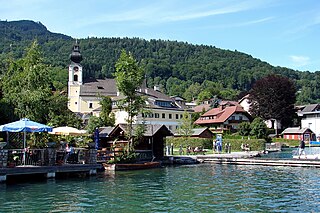
The Salzkammergut is a resort area in Austria, stretching from the city of Salzburg eastwards along the Alpine Foreland and the Northern Limestone Alps to the peaks of the Dachstein Mountains. The main river of the region is the Traun, a right tributary of the Danube.

Krumbach is a market town in southern Lower Austria, Austria. It is part of the landscape Bucklige Welt.
Rohrau is a village in the state of Lower Austria. The name comes from two German words: Rohr (reed) and Au. South of the village is a riparian forest and a swamp covered with reed.

Gmunden is a town in Upper Austria, Austria in the district of Gmunden. It has 13,204 inhabitants.

Laxenburg is a market town in the district of Mödling, in the Austrian state of Lower Austria. Located about 20 km (12 mi) south of the Austrian capital Vienna, it is chiefly known for the Laxenburg castles, which, beside Schönbrunn, served as the most important summer retreat of the Habsburg monarchs.

Traun is an Austrian municipality located on the north bank of the river Traun and borders Linz, the capital of Upper Austria, to the east. The name Traun is derived from the Celtic word for river (dru). Traun is the fifth largest town in Upper Austria, located in the district of Linz-Land.

Sohland an der Spree (German) or Załom is a municipality in the district of Bautzen in Saxony, Germany near the border of the Czech Republic in a region called Lusatia. The river Spree flows through the village. Together with some smaller villages it constitutes one of the biggest villages or communities with about 7,700 inhabitants. The most iconic monument of the village is the "Himmelsbrücke" ; it is said that the bridge will break when someone tells a lie while standing on it.

Kittsee is an Austrian municipality in the District of Neusiedl am See, Burgenland.

Unterach is a village in the Austria state of Upper Austria on the southern shore of lake Attersee in the centre of the Salzkammergut region.

Ahrensbök is a municipality in the district of Ostholstein, in Schleswig-Holstein, Germany. It is situated approximately 17 km northwest of Lübeck, and 45 km southeast of Kiel.

Grafing bei München is a town in the district of Ebersberg, Upper Bavaria, Germany.

Petronell-Carnuntum is a community of Bruck an der Leitha in Austria. It is known for its annual World Theatre Festival.

Lenggries is a municipality and a town in Bavaria, Germany. It is the center of the Isarwinkel, the region along the Isar between Bad Tölz and Wallgau. The town has about 9,500 inhabitants. By area, it is the largest rural municipality ("Gemeinde") in what was formerly West Germany, and the 7th-largest overall.

Glonn is a market town in the Ebersberg district in Upper Bavaria, Germany, about 30 km (19 mi) southeast of Munich.

Schliengen is a municipality in southwestern Germany in the state of Baden-Württemberg, in the Kreis (district) of Lörrach. Schliengen's claim to international fame is the Battle of Schliengen, fought between forces of the French Revolutionary army under Jean-Victor Moreau and the Austrian army under Karl von Österreich-Teschen. As both sides claimed victory, the battle is commemorated on a monument in Vienna and on the Arc de Triomphe in Paris.

Keutschach am See is a municipality in the district of Klagenfurt-Land in the Austrian state of Carinthia.

Obdach is a municipality in the district of Murtal in Styria, Austria.
Oberwölz is a city since 2015 in the Murau District of Styria, Austria. The city was founded as part of the Styria municipal structural reform, at the end of 2014, with the merger of the former independent municipalities Oberwölz Stadt, Oberwölz Umgebung, Schönberg-Lachtal and Winklern bei Oberwölz, whereby the new municipality became ranked as a city ("Stadtgemeinde").

Eggenberg Palace in Graz, is the most significant Baroque palace complex in the Austrian province of Styria. With its preserved accouterments, the extensive scenic gardens, as well as some special collections from the Universalmuseum Joanneum housed in the palace and surrounding park, Schloss Eggenberg ranks among the most valuable cultural treasures of Austria. Eggenberg Palace is situated at an elevation of 381 meters on the Western edge of the city. Its architectural design and the still visible imprint of centuries of history continue to bear witness to the vicissitude and patronage of the one-time mightiest dynasty in Styria, the House of Eggenberg.

Ehrenhausen an der Weinstraße is a municipality with 2,623 residents in the Leibnitz District of Styria, Austria.




















